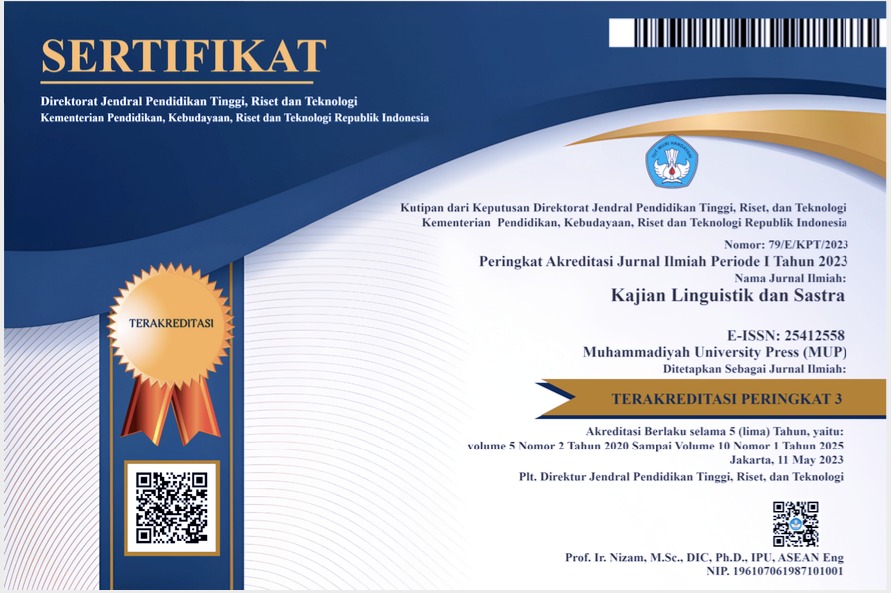Analisis Semiotika Riffaterre dalam Puisi "Hiya Fil Masāi Waḥīdatin” Karya Mahmoud Darwish
Keywords:
puisi, heuristik, hermeneutik, Mahmoud DarwishAbstract
This study aims to uncover the deepest meaning of language signs in Mahmoud Darwish's Hiya Fil Masāi Waḥīdatin poetry using Micheal Riffaterre's semiotic theory. This research uses a descriptive method with qualitative analysis. The source of this research data is the poerty Hiya Fil Masāi Waḥīdatin which consists of 34 lines. In interpreting signs in poetry, Riffaterre offers two concepts of reading. The first stage is through heuristic reading, then hermeneutic reading, followed by models, variants, matrices, as well as hypograms. The results of this study were found in heuristic readings of the meanings that are still ambiguous and heterogeneous. On the other hand, in hermeneutic reading, the model that is in the form of "sadness" is found in stanzas 1 and 2. These two stanzas represent the entire content of the poem, for the whole stanza reflects a man's sorrow for him (his country). Then the model was developed into variants namely sympathy and struggle. The matrix in this poem describes "the meaning of a homeland". The hypogram of Hiya Fil Masāi Waḥīdatin poetry is backed by two poetries, namely Yaumiyātu Jurḥ Filasṭīnī and Al-Waṭan ‘an Syain which have the meaning of suffering from alienation and longing so that a sense of struggle arises.
References
F. Ukhrawiyah dan F. Kurniawati, “Analisis Semiotik Riffaterre pada Syair Lagu Man Anā
Karya Al-Imam Al-Habib Umar Muhdhor bin Abdurrahman Assegaf,” Haluan Sastra Budaya,
vol. 5, no. 2, pp. 140, Des 2021, doi: https://doi.org/10.20961/hsb.v5i2.47238.
Sulista, Cici dan Latif, Abdul, “Analisis Puisi ‘Lau Annana Lam Naftariq’ Karya Farouk
Juwaidah,” Al-Fathin J. Bhs. Dan Sastra Arab, vol. 2, no. 1, pp. 121, Jul 2019, doi:
https://doi.org/10.32332/al-fathin.v2i2.1426.
Culler, Jonathan D., The Pursuit of Signs: Semiotics, Literature, Deconstruction. New York:
Cornell University Press, 2002.
Warsiman, Membumikan Pembelajaran Sastra yang Humanis. Malang: Universitas
Brawijaya Press, 2016.
Hermawan, Sainul, Teori Sastra dari Marxis Sampai Rasis, Sebuah Buku Ajar. Banjarmasin:
FKIP UNLAM, 2006.
Riffaterre, Michael, Semiotics of Poetry. Bloomington: Indiana University Press, 1978.
Hamzah, Mukhotob dan Barrunnawa, Muhammad, “Representasi Keresahan Mahmoud
Darwish dalam Puisi al-Sijn: Kajian Semiotik Riffaterre,” Al-Ma‘rifah J. Budaya Bhs. Dan
Sastra Arab, vol. 18, no. 1, pp. 27–38, 2021, doi:
https://doi.org/10.21009/almakrifah.18.01.03.
Zuhdi, Muhammad Luthfi, “Ruang Ketiga dan Konstruksi Identitas: Hibriditas dalam Karya
Mahmoud Darwish,” Lingua, vol. 18, no. 2, pp. 192–213, 2021, doi:
https://doi.org/10.30957/lingua.v18i2.709.
Bäckström, Per, “Forgive Us,o Life!The Sin of Death: A Critical Reading of Michael
Riffaterre’s Semiotics of Poetry,” Textual Pract., vol. 25, no. 5, pp. 913–939, 2011, doi:
1080/09502361003687811.
Sudaryanto, Metode dan Aneka Teknik Analisis Bahasa. Yogyakarta: Duta Wacana
University Press, 1993.
Zaim, M, Metode Penelitian Bahasa: Pendekatan Struktural. Padang: Sukabina Press, 2014.
Moleong, Lexy J, Metode Penelitian Kualitatif, 38 ed. Bandung: PT Remaja Rosdakarya,
Barador, Raheleh dan Lashkarian, Anita, “Riffaterre’s Semiotics of Poerty in Re-Reading
John Keats’ ‘Bright Star’ and Sepehri’s ‘To the Garden of Co-Travelers,’” Asian J.
Multidiscciplinary Stud., vol. 2, no. 9, pp. 116–122, 2014, doi:
https://paperzz.com/download/8846878.
Zahro, Fatimatuz, “Semiotika Michael Riffaterre dalam Puisi Fî ‘Ainika Unwanî Karya Faruq
Juwaidah,” Tsaqofiya J. Pendidik. Bhs. dan Sastra Arab, vol. 4, no. 1, pp. 75–93, Jan 2022,
doi: https://doi.org/10.21154/tsaqofiya.v4i1.81.
Berger, Arthur Asa, Pengantar Semiotika: Tanda-Tanda dalam Kebudayaan Kontemporer.
Yogyakarta: Tiara Wacana Yogya, 2011.
Bustam, Betty Mauli Rosa, “Analisis Semiotika Terhadap Puisi Rabi’atul Adawiyah dan
Kalimat Suci Mother Teresa,” Analisa, vol. 21, no. 2, pp. 227, Des 2014, doi:
https://doi.org/10.18784/analisa.v21i02.17.
Shiddiq, Muhammad Hasan dan Thohir, Mudjahirin, “Analisis Makna Puisi Aku Melihatmu
karya K.H. Mustofa Bisri: Kajian semiotik Michael Riffaterre,” Humanika, vol. 7, no. 2, pp.
–69, 2020, doi: DOI: https://doi.org/10.14710/humanika.v27i2.31223.
Selden, Raman, Widdowson, Peter, dan Brooker, Peter, A Reader’s Guide to Contemporary
Literary Theory. Great Britain: Pearson Education Limited, 2005.
Pristiono, Adrianus, Dari Zaman ke Metafiksi: Bunga Rampai Telaah Sastra DKJ. Jakarta: Kepustakaan Populer Gramedia, 2010.
Pradopo, Rachmat Djoko, Beberapa Teori Sastra, Metode Kritik dan Penerapannya.
Yogyakarta: Pustaka Pelajar, 1995.
Faruk, Metode Penelitian Sastra, Sebuah Penjelajahan Awal. Yogyakarta: Pustaka Pelajar,
Arifiany, Wulan, “Analisis Semiotika Michaele Riffatarre pada Puisi Fī Bilādiy lā Ihtirāma
Lilfaqīri Karya Anis Syausan,” Jamiy J. Bhs. Dan Sastra Arab, vol. 11, no. 2, hlm. 454–463,
Sep 2022, doi: http://dx.doi.org/10.31314/ajamiy.11.2.454-463.2022.
Kusumaningtyas, Dwi Nur C.S. dan Nugroho, Bayu A., “Semiotic Analysis of Cyber Literature
Mini-Fiction @fiksimini,” Adv. Soc. Sci. Educ. Humanit. Res., vol. 491, hlm. 535–539, 2020,
doi: https://doi.org/10.2991/assehr.k.201201.094.
Erfatporr, Zineh, “Semiotic Analysis of Qasidtol Hozn by Salah Abdel- Saboor According to
Michael Riffaterre Theory,” ADAB-E-ARABI Arab. Lit. Sci., vol. 15, no. 3, hlm. 1–18, Des 2023,
doi: https://doi.org/10.22059/jalit.2023.352697.612622.
Latifi, Yulia Nasrul, “Puisi ANĀ Karya Nāzik Malāikah (Analisis Semiotik Riffaterre),”
Adabiyyāt, vol. 12, no. 1, hlm. 25–55, 2013, doi: https://doi.org/10.14421/ajbs.2013.12102.










